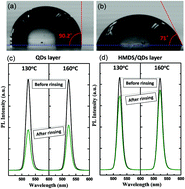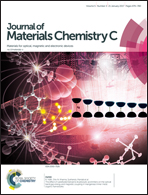Hexamethyldisilazane-mediated, full-solution-processed inverted quantum dot-light-emitting diodes†
Abstract
Fabrication of a multilayered quantum dot-light-emitting diode (QLED) with an inverted architecture cannot be usually fully solution-processed mainly due to the significant destruction of the pre-existing quantum dot (QD) emitting layer (EML) occurring during the subsequent solution-deposition of the hole transport layer (HTL). To overcome this processing difficulty, we devise a simple approach of introducing hexamethyldisilazane (HMDS) to a QD dispersion to modify the surface of the QD film. In sharp contrast to the QD film without HMDS, the HMDS-mediated QD film maintains a high degree of QD integrity without any noticeable damage after HTL solution-processing. Two comparative inverted QLEDs based on original versus HMDS-mediated QDs are fabricated under the same full-solution processing conditions. A remarkable difference in device efficiency is indeed observed, specifically displaying maximum external quantum efficiencies of 2.32 and 11.6% for the former and latter devices, respectively, evidently indicating that our HMDS-mediated strategy is highly effective in well preserving the QD EML and thus achieving a full-solution processed efficient inverted QLED.



 Please wait while we load your content...
Please wait while we load your content...